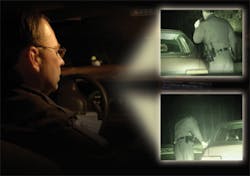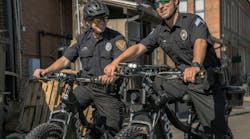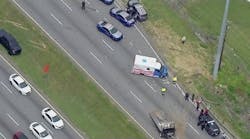Dashboard cameras can give law enforcement officers a good tool for recording criminal activity, or, as one woman discovered, a look at the life she almost lost, when a Greer, South Carolina, officer's dashcam recorded his successful attempt to get her out of her car just before an oncoming train smashed into it.
But dash-cams have also recorded events some many wish had never happened, such as recent incidents causing racial tension in South Carolina. Some individuals fear negative video footage from this department shows human nature is not progressing as quickly as the technology that records it. Consider the following cases involving the South Carolina Highway Patrol:
A mobile video system captured former South Carolina trooper, John Sawyer, kicking Sergio Caridi in the head several times as he lay on the ground following an interstate chase. The incident occurred in 2006, but the video emerged in 2008, and Sawyer was charged with violating the victim's civil rights. Caridi is also suing the South Carolina Department of Public Safety for negligence in training and supervising the accused officer.
Another video, dated April 28, 2007, shows Lance Cpl. Alexander Richardson chasing a suspect, who is on foot, through an apartment complex with his squad car. The car went between buildings and through a common area with a playground, while people scrambled to get out of the way. Richardson struck the suspect with his car, and the man stumbled before he resumed running. Richardson, 45, was reprimanded and ordered to take a stress management course.
Lance Cpl. Steve Garren was also charged with a federal civil rights violation after being caught ramming a suspect with his patrol car on a video dated June 24, 2007. Afterward, Garren reportedly said, "I nailed the f--- out of him. He went flying up into the air." Someone asked, "You hit him?" to which witnesses say Garren responded, "Yeah, I hit him. I was trying to hit him." In October 2008, Garren was acquitted in federal court for violating the civil rights of Marvin Grant.
In another video from December 2004, Lance Cpl. Daniel Campbell can be heard telling a running suspect, "You better run, [racial epithet], because I'm fixing to kill you." After that video emerged, Gov. Mark Sanford forced the resignations of the Department of Public Safety director and highway patrol commander because of their leniency with the officer.
The department is currently reviewing these and other incidents, not just for race relations, but policy violations, according to Sid Gaulden, a spokesperson for the South Carolina Department of Public Safety. Each case will others and decisions will be made based on the findings.
When South Carolina Department of Public Safety Director Mark Keel came on board, he immediately instituted a policy change requiring all personnel to "report and challenge any unethical behavior" of colleagues. Keel also transferred the Office of Professional Conduct to his direct oversight. Additional policy changes could be forthcoming, although Gaulden didn't have any details on such changes as of yet.
The current policy stipulates that officers operating a patrol vehicle equipped with an in-car video recording system activate the in-car system, including the audio portion, as soon as the blue lights and/or siren begin to flash. Once activated, the system is to remain on as long as the officer interacts with the individual(s) being stopped, including times when violator(s) are being transported to a jail or detention facility.
Interactions with citizens that do not involve the use of a blue light and/or siren, are recorded when practical. In all cases involving enforcement activities, once the audio and video recording has begun it is not to be stopped, paused, turned off or otherwise interfered with at any time until the enforcement event is concluded. In cases where the blue light remains activated for safety purposes, the officer at his discretion may terminate the recording. When a trooper turns on blue lights to initiate a traffic stop, the video recording system activates automatically. The trooper does; however, have to turn on his lapel microphone once he exits the vehicle.
To promote a department culture where inappropriate actions are not tolerated, the new director has openly voiced his positions on a number of issues such as lying and providing misleading information, and has indicated that those taking such actions will be dismissed.
The department has had a sensitivity training program in place for approximately nine years. All troopers receive it when they first join the patrol, and it is part of the department's annual in-service training. The program is basically the same as the Florida Highway Patrol's training regimen and consists of a training video, as well as open discussions about racial sensitivity. All trooper trainees receive this training while undergoing patrol training, and all troopers, from colonel on down, undergo refresher courses every year during in-service training. South Carolina officials were granted permission to follow the Florida format.
Positive depictions, too"Though this is in no way a defense for anything that goes on above and beyond the call of duty, you have to keep in mind that there's a lot of stress with this job, and people handle it differently," Gaulden offers as an explanation to the negative officer interactions captured on video. "The goal has been and will continue to be treating all motorists in a uniform manner which does not condone troopers not following departmental policies and procedures. Each of the tapes that have been released to the media came from individual instances where troopers demonstrated questionable behavior. As a result of that behavior, each and every trooper on the tapes was disciplined in some manner."
While the South Carolina Department of Public Safety deals with these incidents, other South Carolina agencies have commented on the fact that this technology typically presents an accurate and positive depiction of an officer's actions at a call.
"The purpose of the camera is to catch the truth; it's there to show what really happened," says George Brothers, homeland security coordinator for Lexington County. "I think those incidents involving the Positive depictions, too
"Though this is in no way a defense for anything that goes on above and beyond the call of duty, you have to keep in mind that there's a lot of stress with this job, and people handle it differently," Gaulden offers as an explanation to the negative officer interactions captured on video. "The goal has been and will continue to be treating all motorists in a uniform manner which does not condone troopers not following departmental policies and procedures. Each of the tapes that have been released to the media came from individual instances where troopers demonstrated questionable behavior. As a result of that behavior, each and every trooper on the tapes was disciplined in some manner."
While the South Carolina Department of Public Safety deals with these incidents, other South Carolina agencies have commented on the fact that this technology typically presents an accurate and positive depiction of an officer's actions at a call.
"The purpose of the camera is to catch the truth; it's there to show what really happened," says George Brothers, homeland security coordinator for Lexington County. "I think those incidents involving the conscious of what we're doing," says Brothers. "It can be easy to forget you're on camera. But if you're aware of what you should be doing, it doesn't matter. If you cannot control yourself, you are in the wrong line of work."
Protecting the departmentFrom law enforcement's perspective, having mobile video of every traffic stop offers a bit of risk management. Many mobile video systems are completely automatic, so that when the officer turns on the lights or activates his wireless microphone the camera starts rolling. Later, when the officer returns to the station, the evidence is automatically uploaded to a computer server and viewed instantly by a supervisor.
In Lexington County, when an officer starts a traffic stop and turns on the squad's lights, the system goes back 60 seconds and captures anything that has been recorded to the DVR's buffer. Probable cause is captured in the first minute and as the stop continues both audio and video are recorded. The stop also can be categorized, such as one using force, with an aggressive suspect. Back at the station, with the wireless hot spots set up, only officers with their own passwords at the administrative level can enter the system to view those videos.
"In terms of chain of custody, once the officer finishes a traffic stop, that evidence is digitally transmitted and we know there has been no one between the officer and the evidence technician or the prosecuting attorney or district attorney," says Brothers. "The chain of custody for the evidence is almost impervious."
This footage lessons liability by preventing a he said-she said type of situation. It shows exactly what occurred as it happened. It is also an excellent training tool, as over the course of a week, a month or a quarter, all the traffic stops can be reviewed, looking for various procedures, verbal patterns or how cars are approached.
"The technology is absolutely there today to protect the town, city or state from illegitimate lawsuits, there to protect the officers themselves and the community so they know there is someone there watching," Brothers says. "The move to digital also means all the procedures involved with using a tape in the camera are eliminated. No one has to store VHS tapes, handle them, and they don't break; there's a lot more room in the evidence room now as well. Retrieval is so much quicker now, versus the VHS tape. An officer's traffic stops can now be burned on a DVD for them to take to court and that's that."
Hudson has noticed a drop in the number of pleas with the technology. "Once those involved in a stop see the video footage they often end up saying, ‘I'm not going to waste my time hiring an attorney.' Likewise, the technology can cut both ways and if an officer is not behaving in a manner they've been taught to behave in, that brings up whole different issues."
Hudson is all for the technology getting even better, and hopes that any glitches involving missing information can be kept to a minimum as well. Unfortunately, in South Carolina the law still tries the video, the data master and the officer before the offender is tried. "Our law remains fairly backward," adds Hudson. "It benefits everyone to have clarity and transparency, and the video in the car really helps that. We're usually first, second, third or fourth highest in the nation in highway fatalities. We've made progress in our laws, but we have a long way to go, too."
Much of that journey will be available on camera.
Freelance writer Peter Hildebrandt's articles have appeared in a variety of trade, general interest and consumer publications. Many of his articles concentrate on environmental, water conservation/reuse and energy issues. He has also written a novel on Edward de Vere, someone a growing number of people now believe to be the author behind the pen name "William Shakespeare."



